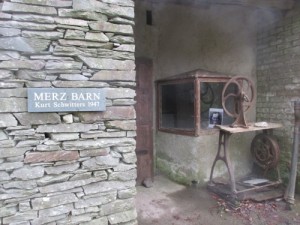The Merzbarn
Jill was recently invited to exhibit her now renowned ‘Sheds’ sculpture installation at the artist Kurt Schwitter’s iconic last studio in the Lake District.
Jill Randall at The Merzbarn. June 18th – July 4th 2014.
“Context is Half the Work”.
APG (Artist Placement Group,1971) .
“Jill Randall at The Merzbarn” is an opportunity to see Randall’s renowned ‘Sheds’ series in the context of one of the world’s most famous and iconic sheds -The Merzbarn, and celebrates the importance of these insignificant spaces in the act of creativity.”
Jill Randall’s work reveals the sublime and beautiful, the poetic and resonant in bleak and unpromising places, and involves making work with and from post-industrial, ‘toxic’, or ‘spoiled’ environments. She responds to odd and extreme places – the ‘abused’ landscapes of Robert Smithson’s Land Art, the peculiar and darkly beautiful volcanic landscapes of the Canary Islands, the “terrible beauty” of the toxic abandoned copper mine at Parys Mountain in Anglesey, industrial estates, power stations, chemical works, old farms, backstreets in working towns.
This installation is a large and ongoing series incorporating the ‘Sheds of Rossendale’, and ‘Sheds of Rochdale’ series. These works explore the overlooked and secretive, celebrating the “ad hoc” and improvised. They began when Jill Randall moved from urban Manchester to semi-rural Lancashire, and began to notice the many improvised (and possibly illegal!) architectural constructions within this landscape when travelling to her studio ; sheds, lean-tos, pigeon shed complexes, barns and industrial buildings.
Jill Randall is intrigued by this conquering of geography and the assertion of ‘territory’ , the rural and industrial interfaces of these places, and the communities that have settled and inhabited them. Her work also explores the relationship of people to place, re-examining land and landscape, people and industry, the ethic of work, and its effect on our lives.
These buildings removed from context have been lovingly recreated, “model-railway” -style, with painstaking attention to detail, using recycled wood, paper and card. Some have been cast into bronze as mock ‘souvenirs’, questioning notions of material value .
..”It always surprises me but where art comes from is spiritually much closer to the dump and discard of the culture…..Provincialism or coarseness or unculture is greater for creating art than finesse or polish .”
“Perfection”, David Smith by David Smith, Sculpture and Writings, Edited by Cleve Gray, Thames & Hudson.1988.


